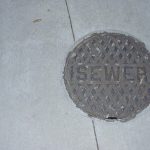A burst water pipe can cause significant damage to your home if not addressed promptly and effectively. Knowing how to handle such a situation can save you time, money, and stress. This article explores five practical methods to fix a burst water pipe: replacing the damaged pipe, using a rubber gasket, applying epoxy putty, removing and replacing damaged piping, and accessing and repairing pipes behind walls. Each method is detailed with step-by-step instructions, tips, and considerations to help you manage plumbing emergencies efficiently and effectively.
1) Replacing the Damaged Burst Water Pipe
Dealing with a burst water pipe by replacing the damaged section is a thorough and permanent solution. This method ensures that the integrity of your plumbing system is restored and future leaks are prevented. Here’s a detailed guide on how to replace a damaged pipe effectively.
Turn Off the Water Supply
The first and most crucial step is to shut off the main water valve. This stops the water flow and prevents further damage. Locate the main valve, typically found near your water meter or where the main water line enters your home, and turn it clockwise to close.
Locate the Leak
Identify the exact location of the burst. This might be visible due to water spraying out or causing dampness. Sometimes, the burst might be behind walls or under floors, requiring more investigative work. Use a flashlight to inspect dark areas and a moisture meter if necessary.
Drain the Pipes
After shutting off the water, open all faucets to drain the remaining water in the pipes. This will make the repair process cleaner and easier. Starting with the highest faucet in your home, move to the lowest to ensure all water is drained.
Cut Out the Damaged Section
Use a pipe cutter to remove the damaged part of the pipe. Measure and mark the section to be cut, ensuring you leave enough room to fit the replacement pipe and connectors. Cut straight and smooth to ensure a good fit for the new pipe. Always wear protective gear like gloves and goggles.
Install the Replacement Pipe
Choose a replacement pipe of the same material (copper, PVC, PEX, etc.) and diameter. Measure the length of the removed section and cut the new pipe to size. Clean the ends of the new pipe and the existing pipe with sandpaper or a pipe cleaning tool to ensure a proper seal. Attach the new pipe using appropriate connectors. For copper pipes, use soldering techniques to secure the joints. For PVC or PEX, use the recommended adhesive or fittings. Ensure all connections are tight and secure.
Test the Repair
Turn the water back on slowly and check for leaks. Open the main valve gradually and inspect each connection closely. If there are no leaks, the repair is successful. If leaks are present, turn off the water and tighten the connections or reapply adhesive.
2) Using a Rubber Gasket
Using a rubber gasket to fix a burst water pipe is a practical and effective method, especially for temporary repairs. This approach is straightforward and can be a lifesaver until a more permanent solution is applied. Here’s an in-depth guide on how to use a rubber gasket to fix a burst pipe.
Turn Off the Water Supply
As with any pipe repair, the first step is to turn off the main water supply. Locate the main valve, which is usually near the water meter or where the main water line enters your home, and turn it clockwise to shut off the water. This step is crucial to prevent further water damage and make the repair process manageable.
Locate the Leak
Identify the exact location of the burst. This might be visible as water spraying out or causing damp spots. If the leak is not immediately visible, you might need to inspect the area closely or listen for the sound of running water. Once you locate the leak, wipe the area dry to prepare it for the gasket.
Prepare the Rubber Gasket
Cut a piece of rubber gasket that is large enough to cover the burst area completely. You can use a piece of an old rubber hose, tire inner tube, or a commercially available rubber patch. Ensure the rubber piece is clean and free of any debris that could affect the seal.
Apply the Rubber Gasket
Place the rubber gasket directly over the burst section of the pipe. Make sure it covers the leak entirely and extends slightly beyond the damaged area for maximum coverage. The rubber acts as a barrier, preventing water from escaping through the burst.
Secure the Gasket with Hose Clamps
Use hose clamps to secure the rubber gasket in place. Position the clamps on either side of the burst, over the rubber gasket, and tighten them using a screwdriver. Ensure the clamps are tight enough to compress the rubber gasket against the pipe, creating a watertight seal. If the burst is extensive, you might need multiple clamps to cover the entire area effectively. For a better seal, you can wrap the rubber gasket around the pipe several times before securing it with clamps. Regularly check the repair to ensure it remains secure and effective, especially if it is a temporary fix.
Note : This method is simple and doesn’t require extensive plumbing skills, while also being cost-effective as rubber gaskets and hose clamps are inexpensive and readily available. Only basic tools, such as a screwdriver and scissors, are required. However, it is not a permanent fix and should be replaced with a more durable repair to ensure the long-term integrity of your plumbing system. Also, it is most effective for small to medium-sized leaks and may not work well for extensive bursts or high-pressure pipes.
3) Applying Epoxy Putty
Epoxy putty is a versatile and effective solution for fixing small to medium leaks in water pipes. It’s a handy product for quick, durable repairs and is particularly useful when a more permanent fix isn’t immediately possible. Here’s a comprehensive guide on how to use epoxy putty to fix a burst water pipe.
Turn Off the Water Supply
The first step in any plumbing repair is to turn off the main water supply. Locate the main valve near your water meter or where the main water line enters your home and turn it clockwise to shut off the water. This prevents further water damage and makes the repair process manageable.
Locate and Clean the Leak
Identify the exact location of the burst. This might be visible as water spraying out or causing damp spots. Clean the area around the leak thoroughly to ensure the epoxy putty adheres properly. Use a rag to dry the pipe and remove any dirt, grease, or rust.
Apply the Epoxy Putty
Epoxy putty typically comes in a stick or tube form, with two components that need to be mixed together. Cut off the required amount of putty and knead it with your fingers until it is a uniform color. This activates the chemical reaction that allows the putty to harden and adhere to the pipe. Press the mixed epoxy putty firmly over the leak. Mold it around the pipe, covering the entire area of the burst. Smooth the edges to ensure a tight seal. Make sure to apply the putty evenly, with enough pressure to push it into any cracks or gaps.
Allow the Putty to Cure
Let the epoxy putty cure according to the manufacturer’s instructions. This typically takes about 5 to 10 minutes to set and 1 hour to fully cure, but curing times can vary. Avoid turning the water back on until the putty is fully hardened to ensure a strong, watertight seal.
Note : Epoxy putty can be sticky and may cause skin irritation, so you must wear gloves to protect your hands and make the application process cleaner. If the pipe is smooth, lightly sanding the area around the leak can help the putty adhere better. This method doesn’t require special tools or extensive plumbing skills, while being perfect for various types of pipes, including PVC, copper, and metal. It provides a strong and durable repair in emergency situations, allowing you to restore water flow quickly and with minimal hassle. While durable, epoxy putty is generally considered a temporary fix, so plan to replace the damaged pipe section for long-term reliability.
4) Removing and Replacing Damaged Piping
Removing and replacing damaged piping is often the most effective way to fix a burst water pipe, offering a permanent solution. This method involves cutting out the damaged section and installing a new piece of pipe, ensuring the integrity and functionality of your plumbing system are fully restored. Here’s a detailed guide on how to undertake this repair.
Turn Off the Water Supply
As with any plumbing repair, start by shutting off the main water valve. This is usually located near your water meter or where the main water line enters your home. Turn the valve clockwise to stop the water flow, preventing further damage and making the repair process manageable.
Drain the Pipes and Locate the Leak
Open all faucets and drain the remaining water in the pipes. Begin with the highest faucet in your home and work your way down to the lowest. This step ensures that the pipes are empty, making the cutting process cleaner and easier. Identify the exact location of the burst. This may involve removing drywall or flooring to access the pipe. Once located, measure and mark the damaged section of the pipe to ensure you remove the correct portion.
Cut Out the Damaged Section
Using a pipe cutter or hacksaw, cut out the damaged section of the pipe. Ensure your cuts are straight and clean to facilitate the installation of the new pipe. For copper pipes, use a pipe cutter for precision; for PVC or PEX, a hacksaw or pipe cutter will work. Always wear protective gear such as gloves and safety goggles when cutting and soldering pipes.
Prepare the Replacement Pipe
Select a replacement pipe of the same material and diameter as the existing pipe. Measure and cut the new pipe to the appropriate length. Clean the ends of the existing pipe and the new pipe with sandpaper or a pipe cleaning tool to ensure a proper fit and seal.
Install the New Pipe
Attach the new pipe section using appropriate connectors. For copper pipes, use soldering techniques to secure the joints. Apply flux to the pipe ends and fittings, then heat the joint with a torch and apply solder until it melts and flows into the joint. For PVC or PEX, use the recommended adhesive or fittings, ensuring all connections are tight and secure.
Test the Repair
Turn the water back on slowly and check for leaks. Open the main valve gradually and inspect each connection closely. If there are no leaks, the repair is successful. If leaks are present, turn off the water and tighten the connections or reapply adhesive.
5) Accessing and Repairing Pipes Behind Walls
Accessing and repairing pipes behind walls can be challenging but is sometimes necessary when a burst pipe is concealed. Here’s a detailed guide on how to do this effectively.
Turn Off the Water Supply
Begin by shutting off the main water supply to prevent further damage. Locate the main valve, typically found near your water meter or where the main water line enters your home, and turn it clockwise to close.
Locate the Leak and Access the Pipe
Identify the area where the leak is located. Look for signs of water damage, such as wet spots, discoloration, or bulging on the walls or ceilings. Sometimes you might hear the sound of dripping or running water behind the wall. Use a utility knife to cut through the drywall or plaster. Start with a small opening to avoid unnecessary damage, and enlarge it as needed to fully expose the pipe.
Assess the Damage
Inspect the exposed pipe to determine the extent of the damage. If the pipe is only slightly damaged, a simple repair might suffice. For extensive damage, you may need to replace the entire section of the pipe.
Repair or Replace the Pipe
If the damage is minor, you can use a repair clamp or epoxy putty to fix the leak. Place the clamp over the damaged area and tighten it to stop the leak, followed by applying the putty over the leak, molding it around the pipe, and allow it to cure. For major repairs, measure and mark the area to be cut, further using a pipe cutter for precise cuts. Attach the new pipe using connectors suitable for the pipe material (copper, PVC, PEX, etc.), securing all joints tightly.
Test the Repair
Turn the water supply back on gradually and check for leaks. Inspect the repaired area closely to ensure there are no drips or dampness. If the repair is successful, proceed to patch the wall.
Patch the Wall
After ensuring the repair is leak-free, patch the wall. Replace the drywall or plaster, tape the seams, and apply joint compound. Sand the area smooth once dry and repaint to match the surrounding wall.
Dealing with a burst water pipe can be stressful, but knowing how to address the issue can significantly reduce the damage and repair costs. By following these methods, you can temporarily or permanently fix the leak and maintain the integrity of your home’s plumbing system.
If you’re unsure about any part of the process or if the leak is extensive, consider consulting a professional plumber. Fixing a burst water pipe can be a complex task, but with careful planning and execution, you can successfully address hidden leaks and restore your plumbing system’s integrity. This detailed approach ensures that the repair is both effective and long-lasting, minimizing the risk of future issues.





